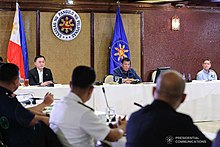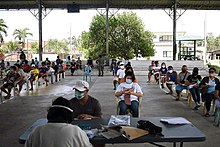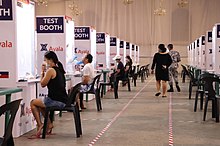
A | B | C | D | E | F | G | H | CH | I | J | K | L | M | N | O | P | Q | R | S | T | U | V | W | X | Y | Z | 0 | 1 | 2 | 3 | 4 | 5 | 6 | 7 | 8 | 9
This article has multiple issues. Please help improve it or discuss these issues on the talk page. (Learn how and when to remove these template messages)
|
| Part of a series on the |
| COVID-19 pandemic |
|---|
 |
|
|
|
Both the national government and local governments have responded to the COVID-19 pandemic in the Philippines with various declarations of emergency, closure of schools and public meeting places, lockdowns, and other restrictions intended to slow the spread of the virus.
National responses and regulations

Measures
Following the confirmation of the first localized transmission on March 7, 2020, the DOH raised its alert to Code Red Sub-Level 1.[1] President Rodrigo Duterte later issued Proclamation No. 922 on March 9, formally declaring a state of public health emergency in the country, authorizing local government units to employ their local disaster risk reduction management funds.[2][3]
The Department of Trade and Industry (DTI) on March 9 issued a directive ordering retailers to only allow the sale of two bottles of each type of disinfectant per person as a measure against hoarding. In line with the public health emergency declaration, the department imposed a 60-day price freeze on basic commodities.[4]
On March 16, the president signed Proclamation No. 929 declaring a state of calamity throughout the country for six months, bringing into effect the following:[5]
- price control of basic needs and commodities,
- granting interest-free loans,
- distribution of calamity funds,
- authorization of importation and receipt of donations, and
- hazard allowance for public health workers and government personnel in the fields of science and technology.[6]
President Duterte signed administrative orders providing daily hazard pay[7] and additional special risk allowance to front line government officials and employees including health workers.[8] The office of Vice President Leni Robredo for its part raised funding for personal protective equipment.[9]
The Department of Labor and Employment[10] and the Department of Social Welfare and Development[11] started their own emergency cash subsidy programs.
Bayanihan to Heal as One Act

Following the sharp increase of confirmed COVID-19 cases, President Duterte called on Congress to hold special sessions on March 23 to enact the Bayanihan to Heal as One Act, which would "authorize the President to exercise powers necessary to carry out urgent measures to meet the current national emergency related to COVID-19 only for three months unless extended by Congress." The act would allow Duterte to "reallocate, realign, and reprogram" a budget of almost ₱275 billion(~US$5.37 billion) from the estimated ₱438 billion(~US$8.55 billion) national budget approved for 2020, in response to the pandemic;[12] enable him to "temporarily take over or direct the operations" of public utilities and privately owned health facilities and other necessary facilities "when the public interest so requires" for quarantine, the accommodation of health professionals, and the distribution and storage of medical relief; and "facilitate and streamline" the accreditation of testing kits.[13]
In the House of Representatives of the Philippines, the bill was introduced as House Bill No. 6616 with House Speaker Alan Peter Cayetano of Pateros–Taguig as its principal sponsor and was defended on the floor by Deputy Speaker Luis Raymund Villafuerte of Camarines Sur's 2nd district. Executive Secretary Salvador Medialdea addressed the session, stressing that the president needed "standby powers" to address the emergency.[14] Some representatives questioned the nature, usage, and necessity of the "standby powers", claiming its susceptibility to abuse and corruption.[15]
In the Senate of the Philippines, the bill was introduced as Senate Bill No. 1418 with Senate President Tito Sotto and Senator Pia Cayetano as its principal sponsors. Under the bill, Cayetano said that over 18 million Filipino households living below the poverty line would also receive financial incentives of around ₱5,000–8,000 (~US$97.45–155.92) per month for two months.[16] Senators amended their version of the bill to include financial compensation of around ₱100,000 ($1,965.33) to be given by PhilHealth to health professionals who contracted the virus, as well as the provision of around ₱1 million-worth (~US$19,653.27) of financial aid to their families.[17]
Both versions of the bill reportedly removed the usage of the term "emergency powers", replacing it with "authority". It also removed the term "take over of public utilities and private businesses", limiting President Duterte's abilities at most to "direct the operations" of such enterprises.[18] The House version of the bill passed the House of Representatives in a 284–9 vote without abstentions,[19] while its Senate version unanimously passed the Senate.[20] Duterte signed the bill into law the following day.[21]
Lockdowns
On March 12, 2020, President Duterte announced a partial lockdown covering the entirety of Metro Manila that was later put into place on March 15.[22] The lockdown was further expanded on March 16, when President Duterte imposed an enhanced community quarantine (ECQ) throughout the entire island of Luzon and its associated islands. This was effectively a total lockdown, which had restricted travel and transportation, imposed strict home quarantine among all households, and closed all non-essential private establishments within the island group.[23][24] This ECQ was extended and reimposed multiple times during the pandemic. Similarly, local governments outside Luzon and Metro Manila have imposed various measures to limit the spread of the virus in their communities. By mid-2020, most of the Philippines were placed in a more relaxed and centralized general community quarantine (GCQ), although certain parts of the country remained with stricter measures. Several clusters of the disease have led to localized lockdowns.[citation needed]
Cash aid
Social amelioration program

The Department of Social Welfare and Development (DSWD) is the agency responsible for the implementation of the national government's social amelioration program (SAP), an emergency cash subsidy meant for indigent families affected by the COVID-19 pandemic and relevant quarantine measures. As of April 14, 2020, around ₱57.8 billion have been released by the social welfare department to the country's 103 local government units (LGUs).[25] The agency targets to make 18 million low-income households as beneficiaries of the program. Households with a family income of less than ₱10 thousand monthly income were given priority. The DSWD has devolved the distribution of the cash subsidy to the LGUS though the agency continues to provide support to the LGUs' efforts including "on-the-spot" validation of beneficiaries.[26]
By May 17, the DSWD had reached 95 percent of its target, providing aid to 17.1 million beneficiary households with ₱96.7 billion worth of cash subsidy distributed.[27]
The DSWD issued multiple warnings regarding misinformation on the cash aid program coming from unsanctioned Facebook pages.[28]
For the second tranche of the SAP, the administration of President Rodrigo Duterte changed the responsibility of distributing cash aid from the local government units to the military and police amid complaints of slow delivery and misuse of funds meant for certain areas.[29]
Universal healthcare
The Philippine Health Insurance Corporation (PhilHealth) announced that it would provide ₱30-billion ($581-million) worth of advance payment to its accredited health facilities for health care providers to obtain the liquid capital required to efficiently respond to the crisis. PhilHealth also subsided some of its policies on its members; it waived the 45-day coverage and single period of confinement policies while extending payment deadlines until the end of April and the failing period of claims from 60 days to at least 120 days. Also, PhilHealth announced that PUIs quarantined in its accredited facilities are entitled to a ₱14,000 ($270) health package, while those who tested positive for COVID-19 are entitled to a ₱32,000 ($580) beneficiary package.[30]
Frontline workers compensation
On March 23, President Duterte signed Administrative Order No. 26, granting that front line government officials and employees receive a daily hazard pay of ₱500 ($9.87).[7] On April 6, President Duterte signed Administrative Order No. 28, granting the payment of a special risk allowance to public health workers in addition to their hazard pay. According to the order, public health workers attending to COVID-19 patients, PUMs, and PUIs will receive at most a quarter of their basic pay.[8]
Other measures
The Presidential Security Group (PSG) have implemented a "no-touch" policy during meetings by President Duterte with politicians, reporters, and visitors.[31] Several government officials announced that they would donate portions of their salaries to help fund government initiatives responding to the pandemic. President Duterte said that he would donate a month of his salary, which amounts to ₱400,000, to the Office of Civil Defense.[32] Some senators and around 200 members of the House of Representatives would also donate their salaries for May, while most Cabinet members would donate at most 75 percent of their salaries.[33][34]
The Department of Labor and Employment (DOLE) announced it would initiate a cash assistance program worth ₱2 billion ($39 million) for workers in both the formal and informal sectors across the country affected by government-imposed quarantines. As of March 31, the department reported that at least 25,428 formal sectors and 5,220 informal sector workers were given cash assistance of ₱5,000 ($98) each.[10]
Medical supply
The office of Vice President Leni Robredo raised about ₱28.8 million ($564,551) to purchase 64,367 sets of PPE and donate it to front line health professionals across the country. The first batch consisted of 7,350 PPEs that were donated to 490 professionals in eight hospitals in Manila and Quezon City with COVID-19 cases.[35] By March 24, Robredo's office had delivered 23,475 sets of PPE to 62 medical facilities and communities across Metro Manila, La Union, and Quezon.[36] Robredo also partnered with fashion designer Mich Dulce to mass-produce PPEs using locally sourced Taffeta fabric; the Vice President pledged to help donate the PPEs to medical professionals across the country.[37]
Mass testing

As part of the national government's efforts to conduct mass testing, it began setting up "mega swabbing centers" in May 2020 by repurposing various existing facilities. The first of such facilities opened at the Palacio de Manila along Roxas Boulevard on May 5. These facilities use reverse transcriptase polymerase chain reaction (RT-PCR) kits.[38] The facilities are meant to prioritize the testing of around 25,000 overseas Filipino worker repatriates.[39] Two more facilities opened: at the Enderun Colleges in Taguig and the Mall of Asia Arena in Pasay[39]
A fourth facility was opened on May 20, 2020, at the Philippine Arena to test residents of Bulacan and Metro Manila. All swab samples collected from the testing centers will be processed by the Philippine Red Cross.[40]
As of September 2020, the Philippine Government had reported that over 3 million people have been tested.[41]
Zdroj:https://en.wikipedia.org?pojem=Philippine_government_response_to_the_COVID-19_pandemic
Text je dostupný za podmienok Creative Commons Attribution/Share-Alike License 3.0 Unported; prípadne za ďalších podmienok. Podrobnejšie informácie nájdete na stránke Podmienky použitia.
Antropológia
Aplikované vedy
Bibliometria
Dejiny vedy
Encyklopédie
Filozofia vedy
Forenzné vedy
Humanitné vedy
Knižničná veda
Kryogenika
Kryptológia
Kulturológia
Literárna veda
Medzidisciplinárne oblasti
Metódy kvantitatívnej analýzy
Metavedy
Metodika
Text je dostupný za podmienok Creative
Commons Attribution/Share-Alike License 3.0 Unported; prípadne za ďalších
podmienok.
Podrobnejšie informácie nájdete na stránke Podmienky
použitia.
www.astronomia.sk | www.biologia.sk | www.botanika.sk | www.dejiny.sk | www.economy.sk | www.elektrotechnika.sk | www.estetika.sk | www.farmakologia.sk | www.filozofia.sk | Fyzika | www.futurologia.sk | www.genetika.sk | www.chemia.sk | www.lingvistika.sk | www.politologia.sk | www.psychologia.sk | www.sexuologia.sk | www.sociologia.sk | www.veda.sk I www.zoologia.sk
